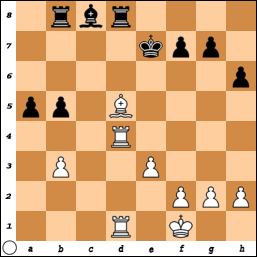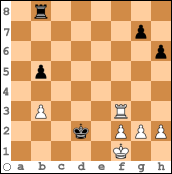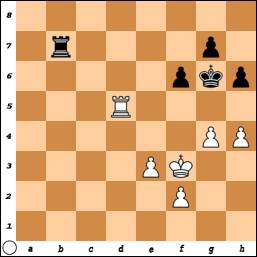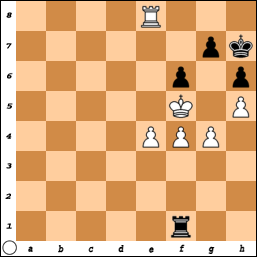In the recent 4NCL I had the honour of playing first board for Wood Green with Black in two games. As I am entirely out of shape and blunder in more or less every rare game I play, my goal was to make draws, eliminate their best players and hope that the team would win on the other boards. This all went to plan and I gladly donated 1-2 rating points to the well-being of the team. Besides, I hope I will be allowed three white games in the final weekend!
My game on the Saturday was quite interesting at one moment, just after I blundered (always happens!) and I had to decide how best to deal with the defence. I think my considerations at the board were quite interesting and worth a minor discussion.
James Cobb – Jacob Aagaard
1.Nf3 Nf6 2.c4 c6 3.Nc3 d5 4.e3 e6 5.b3 Bd6 6.Bb2 Nbd7 7.d4 0–0 8.Be2 Re8 9.0–0 Qe7 10.Qc2 dxc4 11.Bxc4
11.bxc4 e5 12.Nh4 Nf8 13.Nf5 Bxf5 14.Qxf5 exd4 15.exd4 Ne6 looks OK for Black. During the game I was slightly less sure, but I was going to play this way and that is what counts.
11…h6 12.Ne4 Nxe4 13.Qxe4 e5 14.dxe5 Nxe5 15.Nxe5 Bxe5 16.Qxe5 Qxe5 17.Bxe5 Rxe5 18.Rfd1 Kf8 19.Rd8+ Re8 20.Rad1 a5 21.a4 Rb8 22.R8d4 b5 23.axb5 cxb5 24.Bd5 Rd8 25.Kf1 Ke7

This is my blunder. I really had no clue that this was coming. As usual when this happens, I smiled. Life has lots of surprises for us; not all will be positive.
26.Ra1!
OK, so I am about to lose a pawn. Life is tough. But it is up to me how I am going to lose the pawn.
The most obvious option is to go for active play with: 26…Be6 27.Bxe6 Rxd4 28.exd4 Kxe6 29.Rxa5 Kd5 30.Ra7 Kxd4 31.Rxf7 Kc3 32.Rf3+ Kd2

I calculated this far and decided that although Black might have enough counterplay, I did not want to rely on my tactical abilities. This was a practical decision, based on often coming up with long variations that turn out to have no hold in reality. However, in this case Black actually does have enough counterplay and my mistrust in myself was not warranted. 33.h4 Rc8 34.g4 b4 35.Kg2 Rc3 36.Rf7 Rxb3 37.Rxg7 Rc3 and Black draws easily.
The alternative was to give up the a-pawn and attempt to get a position I knew from Korchnoi’s little book of rook endings, specifically the analysis to Korchnoi – Aronin. I knew that there was quite a bit of way to go from the initial ending till the target position, but I felt more confident going for this than for long analysis. Maybe I am just getting old?
26…a4!? 27.bxa4 bxa4 28.Raxa4 Rb1+ 29.Ke2 Rb2+ 30.Kf3 Rxd5 31.Rxd5 Bb7 32.Ra7 Kf6 33.Rxb7 Rxb7 34.g4 Kg6 35.h4 f6

James was thinking a lot from here on. He quickly worked out where I was heading, but did not find a way where he could activate the king without Black getting counterplay against the pawns. I did not find it either and I suspect it is not there.
36.Kf4 Rb2 37.f3 Re2 38.e4 Rh2 39.Kg3 Re2 40.Rb5 Kh7 41.Kf4 Rh2 42.h5 Re2 43.Rb3 Ra2 44.Rd3 Ra5 45.Ke3 Ra4 46.Rb3 Kg8 47.Kf4 Ra5 48.Rd3 Kh7 49.Re3 Kg8 50.Rb3 Kh7 51.Rb7 Ra3 52.Re7 Kg8 53.Kf5 Kh7 54.f4 Rf3 55.Re8 Rf1

This is the target position. White is not able to create a passed pawn.
56.e5 fxe5 57.Rxe5 Rf2 58.Re4 Rf1 59.Ke6 Rg1 60.f5 Kg8 61.Ke7 Rg2 62.f6 gxf6 63.Kxf6 Kh7 64.Re7+ Kh8 65.Kf5
65.Rg7 Rf2+ 66.Kg6 Rf6+ 67.Kxf6 Stalemate.
65…Rg1
Rather than allowing a stalemate trick, James simply offered a draw. As Andrew blew a winning pawn ending simultaneously on board four, we “only” won the match 7-1. I have to say that I do enjoy drawing on board one and then having the rest of the team winning, but not this time around unfortunately…
Good technique!
@Dennis M
The most lovely thing about it was that Speelman congratulated me, not knowing Korchnoi – Aronin! But Gelfand just brushed it aside: “I already held this in 1983…”
It reminds me of an endgame of Dvoretsky. Material is still even, but he is under pressure. Then he can choose to exchange in a rook endgame where he is a pawn dwon, but 3-3 on one wing, 1 down on the other, but with his rook behind this pawn. He plays this endgame because he is certain he will hold it, draws without problems and later is made fun of a little because he voluntarily parts with his pawn. Personally, I think he made a very wise choice from a practical point of view.
@Jacob Aagaard
Thank you for this instructive post!
Just out of curiosity, do you know which game of Gelfand’s featured this endgame?
@Oscar
I remember Mark giving a lecture on this game 15 years ago. Akopian – Georgiev had the same idea, but there Black did not draw!
In response to Kieran’s question about which Gelfand game it was, a search of Megabase shows it was E Mochalov v B Gelfand in the Belarus championships.
Found it in last K.Müller book on rook endings